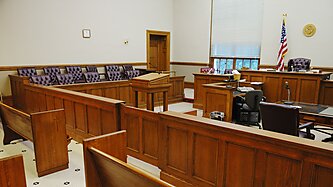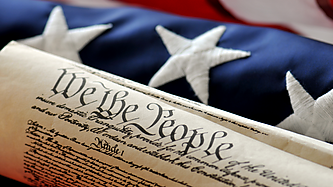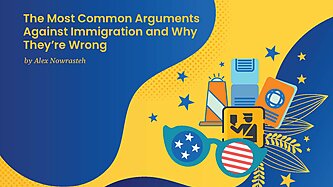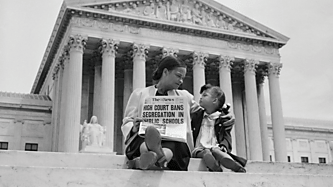- Understand the historical context of Brown v. Board of Education.
- Examine the ongoing impact of Brown v. Board on education and society in the United States.
foundations of civics and economics lesson
Brown v. Board: How Does It Continue to Shape America?
Brown v. Board of Education, a landmark Supreme Court decision in 1954, played a pivotal role in dismantling racial segregation in American schools.
Foundations of Civics and Economics
6-part unit
-
Rule of Law and the Death Penalty
-
The Struggle for Equal Rights from the Founding to Today
-
Discussion Questions: The Most Common Arguments Against Immigration and Why They’re Wrong
-
Immigration: Is History Repeating Itself?
-
Checks and Balances and Separation of Powers
-
Brown v. Board: How Does It Continue to Shape America?
Lesson Objectives
Essential Questions
- Why was Brown v. Board of Education a landmark case in US history?
- What role did Brown v. Board play in the broader context of the civil rights movement?
- What evidence exists of ongoing challenges related to educational inequality in the United States?
- In what ways can individuals and communities work toward achieving the principles of Brown v. Board today?
Media
Part I: Brown v. Board—History
Brown v. Board in Images
The media the students will be talking about should be on display as the students walk in. This media should be easy to interpret but also have layers of meaning that encompass what rights were won and worth fighting for in terms of Brown v. Board. Examples: “The Problem We All Live With” by Norman Rockwell or any image that can be found when searching online for “Brown v. Board.”
Warm‐up Activity
Journal prompt: What does this image mean to you? How does it relate to the civil rights movement? How does it relate to civil rights today?
Class Activity 1
Students need to know and understand what led to the Brown v. Board decision. You can do this any number of ways, but a living timeline shows students all that happened before the Civil War up until the decision in 1954. Look at the rulings that can be found at the National Archives (“Timeline of Events Leading to the Brown v. Board of Education Decision of 1954”).
Give pairs and/or small groups of students a piece of chart paper, one of the events from the archive, and time to research the event.
- They can start with the information from the National Archives article, or you can have them do their own research with just the title of the event.
- Each pair or group needs to create a poster that shares information about their given event. This information should include the date really big at the top and then words, phrases, drawings, etc. that show what the event is and the significance of the event.
1857: Dred Scott, Plaintiff in Error v. John F. A. Sanford
1866: Civil Rights Act of 1866
1868: Ratification of the 14th Amendment to the Constitution
1875: Civil Rights Act of 1875
1896: Plessy v. Ferguson
1909: Founding of the National Association for the Advancement of Colored People
1935: NAACP begins challenging segregation in graduate and secondary schools
1938: State of Missouri ex rel. Gaines v. Canada
1949: Briggs v. Elliott
1950: Sweatt v. Painter
1950: McLaurin v. Oklahoma State Regents
May 17, 1954: Supreme Court Rulings: Bolling v. Sharpe
Skip Brown v. Board as it will be discussed during the next class period.
- Students should share their poster information in chronological order and then post the posters on the wall for all to see.
Reflection: What do you notice about the events? What are the causes and effects? What is the timeline of the events?
Closing the Lesson
These questions can be used at the end of class to bring the topics of today’s lessons together:
- Who benefited from these events?
- Who benefits now?
Part II: Brown v. Board—Today
Review of Brown v. Board
Warm‐up Activity
Journal prompt: What is Brown v. Board, and how did it shape the United States?
Discuss the major components of what led to the decision. Have students make inferences about what the decision is and what it did for the United States based on the activities from the previous class period.
Please make sure that the posters from the previous class period are still up for the students to look at and read.
Class Activity 2
Have students read the Brown v. Board ruling transcript in pairs or small groups. Instead of dividing it up for them, let the groups decide how they will read the transcript. Give a copy of the transcript to each person to read and look over. Give each pair or group time to read and mark up the text. They should look at the transcript in terms of the following:
- what the decision did immediately;
- how it was challenged right after (see what they know about history);
- how it is being challenged now (inferences are good here);
- the most important parts of the decision; and
- the key takeaway (a quote with explanation).
Share with students the modern‐day challenges to Brown v. Board. Look at the list below for videos, images, and articles that suit you, your classroom, and your district.
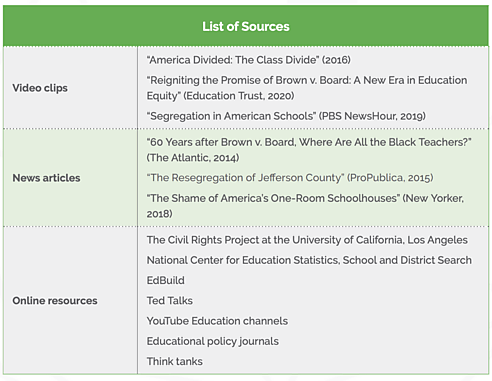
Closing the Lesson
These questions can be used at the end of class to bring the topics of today’s lessons together:
- Have the goals of Brown v. Board been fully realized?
- Why or why not?
Common Core State Standards
- RH.11–12.1: Cite specific textual evidence to support analysis of primary and secondary sources.
- RH.11–12.2: Determine the central ideas or information of a primary or secondary source.
- RH.11–12.7: Integrate and evaluate multiple sources of information presented in diverse formats and media.
- WHST.11–12.2: Write informative/explanatory texts, including the narration of historical events, scientific procedures/experiments, or technical processes
- WHST.11–12.4: Produce clear and coherent writing in which the development, organization, and style are appropriate to task, purpose, and audience.
- SL.11–12.1: Initiate and participate effectively in a range of collaborative discussions.
- SL.11–12.2: Integrate multiple sources of information presented in diverse formats and media to make informed decisions.
- L.11–12.2: Demonstrate command of the conventions of standard English capitalization, punctuation, and spelling.
- L.11–12.6: Acquire and use accurately general academic and domain‐specific words and phrases.
Cross‐Curricular Connections
Integration of Information and Technology Skills
CCSS.ELA-LITERACY.WHST.11–12.8: Gather relevant information from multiple authoritative print and digital sources
Critical Thinking and Analysis
CCSS.ELA-LITERACY.RH.11–12.9: Integrate information from diverse sources, both primary and secondary, into a coherent understanding of an idea or event.
Research Skills
CCSS.ELA-LITERACY.WHST.11–12.7: Conduct short as well as more sustained research projects.
